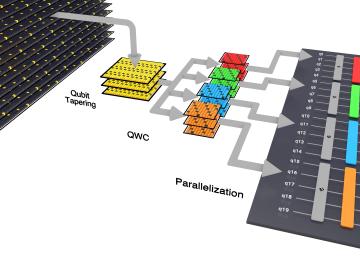Filter News
Area of Research
- (-) Neutron Science (72)
- (-) Supercomputing (153)
- Advanced Manufacturing (5)
- Biological Systems (1)
- Biology and Environment (102)
- Biology and Soft Matter (4)
- Building Technologies (2)
- Chemical and Engineering Materials (3)
- Chemistry and Physics at Interfaces (7)
- Clean Energy (168)
- Climate and Environmental Systems (7)
- Computational Biology (1)
- Computational Chemistry (5)
- Computational Engineering (1)
- Computer Science (3)
- Data (1)
- Earth Sciences (1)
- Electricity and Smart Grid (1)
- Energy Frontier Research Centers (7)
- Fuel Cycle Science and Technology (2)
- Functional Materials for Energy (8)
- Fusion and Fission (32)
- Fusion Energy (7)
- Geographic Information Science and Technology (1)
- Isotopes (21)
- Materials (122)
- Materials for Computing (13)
- Materials Synthesis from Atoms to Systems (8)
- Materials Under Extremes (7)
- National Security (45)
- Neutron Data Analysis and Visualization (2)
- Nuclear Science and Technology (27)
- Quantum Condensed Matter (3)
- Quantum information Science (4)
- Renewable Energy (2)
- Sensors and Controls (2)
- Transportation Systems (4)
News Type
News Topics
- 3-D Printing/Advanced Manufacturing (4)
- Artificial Intelligence (22)
- Big Data (13)
- Bioenergy (5)
- Biology (6)
- Biomedical (10)
- Biotechnology (1)
- Buildings (2)
- Chemical Sciences (1)
- Clean Water (2)
- Climate Change (12)
- Computer Science (47)
- Coronavirus (7)
- Cybersecurity (2)
- Decarbonization (4)
- Energy Storage (3)
- Environment (16)
- Exascale Computing (12)
- Fossil Energy (1)
- Frontier (13)
- Grid (1)
- High-Performance Computing (20)
- Machine Learning (9)
- Materials (9)
- Materials Science (13)
- Mathematics (1)
- Microscopy (2)
- Nanotechnology (6)
- National Security (3)
- Net Zero (1)
- Neutron Science (35)
- Nuclear Energy (3)
- Physics (4)
- Polymers (1)
- Quantum Computing (10)
- Quantum Science (10)
- Security (2)
- Simulation (10)
- Software (1)
- Space Exploration (2)
- Summit (21)
- Sustainable Energy (3)
- Transportation (4)
Media Contacts

Outside the high-performance computing, or HPC, community, exascale may seem more like fodder for science fiction than a powerful tool for scientific research. Yet, when seen through the lens of real-world applications, exascale computing goes from ethereal concept to tangible reality with exceptional benefits.

Autonomous labs are changing the nature of scientific investigation. Instead of humans manually orchestrating every part of an experiment, programmed equipment can carry out necessary functions. This workflow accelerates the pace of discovery by reducing the number of monotonous tasks that researchers must perform.

A group at the Department of Energy's Oak Ridge National Laboratory made a difference for local youth through hands-on projects that connected neutron science and engineering intuitively.

For more than half a century, the 1,000-foot-diameter spherical reflector dish at the Arecibo Observatory in Puerto Rico was the largest radio telescope in the world. Completed in 1963, the dish was built in a natural sinkhole, with the telescope’s feed antenna suspended 500 feet above the dish on a 1.8-million-pound steel platform. Three concrete towers and more than 4 miles of steel cables supported the platform.

Hosted by the Quantum Computing Institute and the Oak Ridge Leadership Computing Facility, the fourth annual event brought together over 100 attendees to discuss the latest developments in quantum computing and to learn about results from projects supported by the OLCF’s Quantum Computing User Program.

ORNL hosted its fourth Artificial Intelligence for Robust Engineering and Science, or AIRES, workshop from April 18-20. Over 100 attendees from government, academia and industry convened to identify research challenges and investment areas, carving the future of the discipline.

Quantum computing sits on the cutting edge of scientific discovery. Given its novelty, the next generation of researchers will contribute significantly to the advancement of the field. However, this new crop of scientists must first be cultivated.

Using the full capabilities of the Quantinuum H1-1 quantum computer, researchers from ORNL not only demonstrated best practices for scientific computing on current quantum systems but also produced an intriguing scientific result.

Wildfires have shaped the environment for millennia, but they are increasing in frequency, range and intensity in response to a hotter climate. The phenomenon is being incorporated into high-resolution simulations of the Earth’s climate by scientists at the Department of Energy’s Oak Ridge National Laboratory, with a mission to better understand and predict environmental change.

Over the past decade, teams of engineers, chemists and biologists have analyzed the physical and chemical properties of cicada wings, hoping to unlock the secret of their ability to kill microbes on contact. If this function of nature can be replicated by science, it may lead to products with inherently antibacterial surfaces that are more effective than current chemical treatments.




